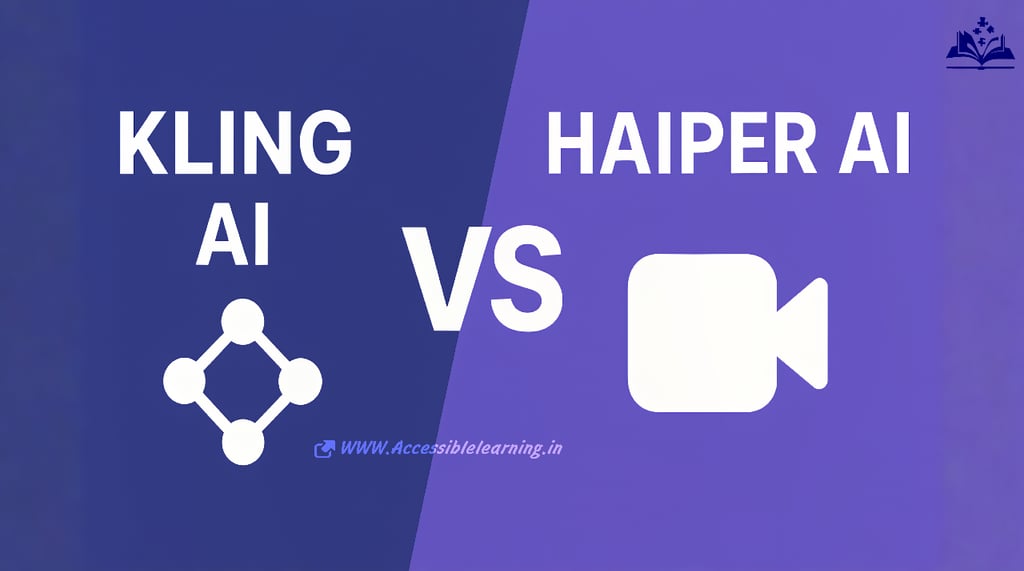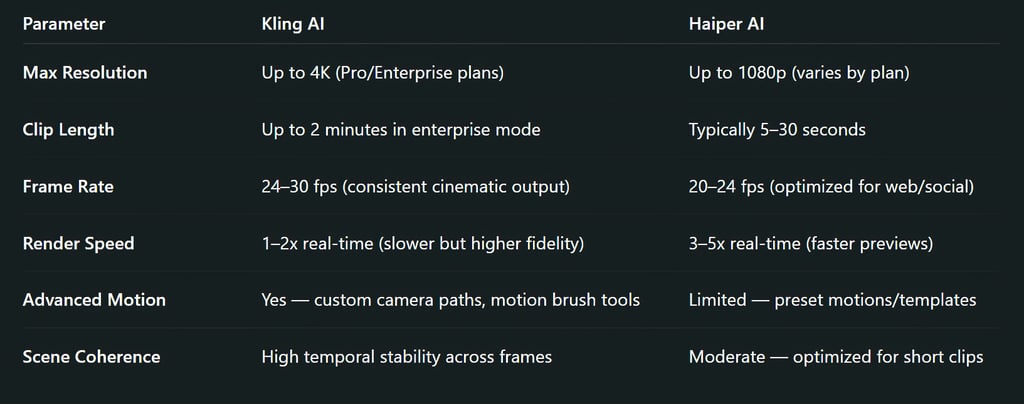
Kling AI vs Haiper AI – Full Comparison for Creators & Marketers
Compare Kling AI vs Haiper AI in 2025. Features, quality, pricing, and use cases for creators, marketers, and enterprises seeking the best AI video tool.
AI ART TOOLSAI/FUTURECOMPANY/INDUSTRYARTIST/CREATIVITY
Sachin K Chaurasiya
8/20/20253 min read


Kling AI and Haiper AI are leading AI video generation platforms, each catering to different creative needs. Kling AI, developed by Kuaishou, is known for photorealistic, production-grade videos with advanced editing controls. Haiper AI focuses on fast, affordable video creation for social media and marketing.
Kling AI
Generation modes: Text-to-video, image-to-video, and multi-element scene editing.
Controls: Advanced camera movements, motion control, object manipulation.
Output quality: High realism, smooth motion, cinematic styles.
Editing tools: Motion brush, scene extension, and loop creation.
Integrations: API access for enterprise workflows.
Use cases: Short films, commercials, realistic simulations, high-end marketing.
Pricing & Plans
Free tier: Watermarked, limited resolution.
Paid tiers: $20–$60/month for creators; custom pricing for enterprise.
Commercial use: Allowed in paid tiers; full license needed for broadcast.
(Always verify the latest terms as pricing and usage rights change frequently.)
Best For
Film studios needing realistic CGI
Agencies producing premium campaigns
Professional creators seeking advanced scene control
Strengths
Industry-leading realism
Advanced editing & camera control
Scalable for enterprise
Weaknesses
Slower render time than lightweight tools
Higher cost for premium tiers
AI Model Architecture & Core Technology
Likely built on a diffusion-based video generation backbone combined with transformer layers for temporal consistency.
Integrates multi-frame attention mechanisms to ensure object coherence across frames.
Camera motion control uses parametric trajectory mapping for cinematic effects.
Trained on large-scale licensed video datasets to improve realism and motion smoothness.
Utilizes temporal super-resolution models for upscaling to HD/4K.
Workflow & Integration Capabilities
API Access—Yes, available for enterprise integration.
Batch Rendering—Supported for bulk video generation.
Pipeline Integration—Can connect to editing suites like Adobe Premiere and DaVinci Resolve via export formats.
Version Control—Supports iterative project updates with frame-accurate adjustments.
File Formats—MP4 (H.264/H.265), MOV (ProRes on enterprise tiers).
Strengths in Real-World Use
High-end advertising & cinematic production.
Virtual set creation for films and TV.
Long-form video sequences with consistent characters and environments.
AI-assisted storyboarding with precise motion direction.


Haiper AI
Generation modes: Text-to-video, image animation, and video repainting.
Controls: Style templates, basic timing adjustments, and fast preview renders.
Output quality: Stylized or semi-realistic, optimized for quick delivery.
Editing tools: Template-driven customization, rapid scene generation.
Integrations: Works with creator platforms and simple export tools.
Use cases: Social media ads, explainer clips, educational shorts, and TikTok/Reels content.
Pricing & Plans
Free tier: Watermarked, limited clip length.
Paid tiers: $10–$30/month for creators.
Commercial use: Allowed in paid tiers; certain templates may have attribution requirements.
(Always verify the latest terms as pricing and usage rights change frequently.)
Best For
Social media marketers
Independent creators
Educators producing quick explainer videos
Strengths
Fast and easy to use
Affordable pricing
Perfect for short-form content
Weaknesses
Less realism compared to Kling
Limited advanced editing features
AI Model Architecture & Core Technology
Uses a lightweight diffusion + GAN hybrid for faster rendering at a lower computational cost.
Incorporates keyframe interpolation for quick motion generation.
Style-driven templates rely on pretrained aesthetic encoders for faster style transfer.
Trained with a mix of open-source and licensed media for creative flexibility.
Focused on low-latency inference, enabling near-instant previews.
Workflow & Integration Capabilities
API Access—Limited or partner-only.
Batch Rendering—Not native, more manual processing.
Pipeline Integration—Direct social media export (TikTok, Instagram, YouTube Shorts).
Version Control—Basic save-and-reuse prompt system.
File Formats—MP4, WebM (web-optimized).
Strengths in Real-World Use
Rapid marketing asset generation.
Educational shorts and animated explainers.
Social-first content strategies (Instagram, TikTok, YouTube Shorts).
Budget-conscious creative workflows.


Security, Privacy, and Ethics
Kling AI: Implements dataset provenance tracking and rights verification for enterprise users.
Haiper AI: Uses content moderation filters to block NSFW or infringing prompts.
Both comply with major AI safety guidelines, but Kling AI’s enterprise positioning means it places heavier emphasis on content rights audits.
Choose Kling AI for cinematic realism, production-grade projects, and professional workflows.
Choose Haiper AI for quick-turnaround, budget-friendly videos for social media and marketing.
FAQ
Q: Which AI video generator is more realistic?
Kling AI produces more lifelike videos.
Q: Which platform is better for short marketing videos?
Haiper AI.
Q: Do both have free plans?
Yes, both offer free tiers with limitations.
Q: Which is more affordable?
Haiper AI has lower-cost paid options.
Q: Can both be used commercially?
Yes, but commercial rights depend on your subscription tier.
Subscribe to our newsletter
All © Copyright reserved by Accessible-Learning
| Terms & Conditions
Knowledge is power. Learn with Us. 📚


